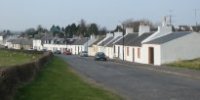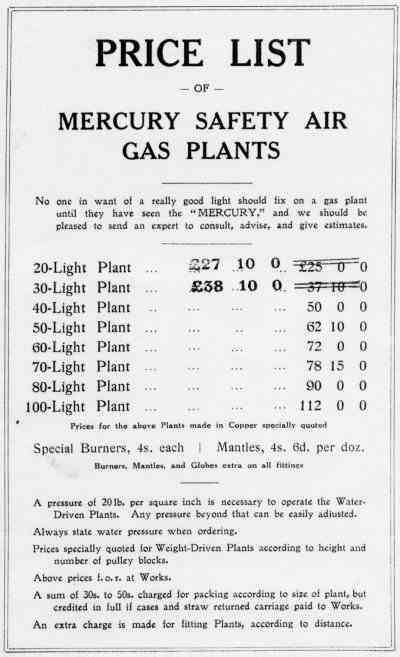plate 1 (below) |
In Ayrshire
Notes 16, the present author describes two rival gas works
operating in Newmilns and fighting it out in great contention. The
burgh was a source of amusement for the people of the neighbouring
villages through its claim to have two of everything, signifying
its public utilities and civic institutions. However in this case
the correct number vaunted was three. The two establishments mentioned
in the earlier article produced coal gas, but just off Main Street
a small factory also known as the 'gas works' was in business.
The Mercury Gas Company resembled in entrepreneurial flair many
small firms in Ayrshire towns that were trading successfully in
national and international markets. In time many were gobbled up
by predators or had their product replaced by modern equivalents
or new sources of energy, but the Mercury had a healthy existence
during the first decades of the twentieth century under the ownership
and direction of John MacPherson. First described as a plumber he
later, when he had established his company, transmogrified himself
into a gas engineer. Both designations were appropriate when it
came to buying in the cylinders and machined parts for the apparatus
and linking them with the necessary mechanism and pipes.
The plant provided heating and lighting to premises in isolated
localities, such as farms and country houses, not attached to the
main gas supplies, or to customers who chose to be independent of
the town gas companies. It was suitable for schools (such as the
Grammar School, Pocklington, East Riding of Yorkshire), reading
rooms (such as Drymen, Stirlingshire) and small businesses, such
as the Premier Tanneries in Glengarnock. Plate 1 shows the more
popular model of water-driven plant that could be adapted to supply
households and premises with the required number of lights or heating
apparatus. A 150 light plant was installed at Drumshoreland Hospital,
near Broxburn, West Lothian. The architect of the hospital approved
it for its 'special feature of conveying its own air in the pipes,
thereby saving the air in the rooms from being robbed of oxygen
which is so essential for sick rooms. [It] is quite a triumph from
a health point of view, and should commend itself to all public
and private institutions where a pure atmosphere is valued.' (note
1)
The system had clear economic advantages over coal gas, which cost
around 3s 6d (171/2p) per 1000 cubic feet. At the same period the
Mercury was run on a mixture of air and petrol, 971/2% air to 21/2%
petrol, operated by a small water engine with a pressure of 20 lbs.
In one test, using a quarter of a gallon of petrol, costing at that
time about 1s (5p) a gallon, '219 cubic feet of air gas were made
and consumed through ten burners throughout the house, using 36
gallons of water costing 0.216 pence, less than a farthing.' (note
2) Advantages of the system were the elimination of condensation
and, as a safety gas, it eradicated all chance of asphyxiation or
explosion in any apartments where the gas burned. No unpleasant
odours were produced and, as an automatic plant, it turned itself
on when one light was ignited and stopped working when the last
light was extinguished. If circumstances prevented the use of water
or it was not available the plant could be operated by weight and
pulley as shown in Plate 2.
All the standard equipment necessary for lighting, heating and cooking
could be operated from the installation: lights, radiators, boilers,
cookers, irons, gas fires and even ironing machines, which were
given a favourable report by Mr Watson of the Loudoun Laundry Co.
Another satisfied customer further afield, but in the same line
of work was the D & J Tullis Laundry in South Africa. Some of
the wide range of products offered by the company are shown in Figures
1 and 2, but every type of domestic and industrial appliance used
in the coal gas industry could also be used in the Mercury system
The widespread and international utilisation of the Company's plant
is indicated by the addresses of a selection of its clients:-
Oil Well Engineering Co., Cheadle, Manchester
Burmah Oil Co., Burmah
Hall, Leslie & Co., Buenos Aires, Argentina
Mr Buchanan, Tobago
Mr Harry Moore, 8-10 Petit Dock, Ghent, Belgium
Fumigalli & Co., heating engineers, Genova, Italy
M. Ruffenacht, Rue de Versailles, Paris
Cuckney Church, Nottinghamshire
After quick growth following the launch of the business with prospects
of further improvement, the company settled down into a regular
steady trade. It displayed its various models and techniques at
many industrial exhibitions winning awards, including the prestigious
gold medal at Manchester in 1910. An office with a showroom was
opened in Bath Street, Glasgow, moving later to West Regent Street,
while the works remained throughout in Newmilns. An undated price-list
of the company's products is shown in Figure 3, and it maintained
a stake in the market until the outbreak of the Second World War.
The company, regardless of the appeal of its product and its competitive
edge, could not hope to survive without an enlarged sales force
and an increased works capacity. Branch factories in areas most
suited for commercial development might have nourished further growth,
but alternative systems of motive power and lighting in rapidly
expanding coal gas and electricity enterprises contributed to the
company's stagnation. The cleanliness, efficiency and safety of
the company's gas plant might have maintained a niche in the market,
but the pre-war development of bottled gas, including Calor Gas,
endangered the Mercury's on-site mechanical system. Without access
to the company records, the ebb and flow of its business activity
cannot be traced. It remained a family concern with limited prospects
for expansion even with its widespread commercial outlets.
Many small businesses, unless they acquired government orders, suffered
eclipse during the Second World War. The Mercury Safety Air Gas
Co was already in decline and the last references to its existence
lie in the valuation rolls for the Burgh of Newmilns & Greenholm
for 1940. What was described as the company's premises at Main Street
from 1911 onwards as a workshop had by 1940 become merely a store.
By the end of the war it was recorded as vacant premises, which
soon after were cleared of all residual equipment and materials
to be converted into the local fire brigade station.
At one time the 'gas works' had formed part of a small industrial
complex alongside Thomson's aerated water factory and Todd's stocking-making
workshop, all within a typical townscape of domestic housing, retail
shops, factories and workshops. Most people lived by or near their
place of work in small, self-sufficient communities. The trend towards
the much-acclaimed economies of scale in business endeavour soon
gave the coup de grace to most small forms as the move to larger
units accelerated. These were located at a distance, and the social
and economic structure of small towns and villages was weakened
or disintegrated. The Mercury Gas Company characterised the enterprise
and acumen of a period of industrial development unlikely ever to
be repeated.
Notes
1. William Baillie, architect, Glasgow, quoted in the business
brochure of the Mercury Safety Air Gas Co Ltd., p.14.
2. Brochure of Mercury Safety Air Gas Co Ltd., p.2.
© Jim Mair 2003
|









